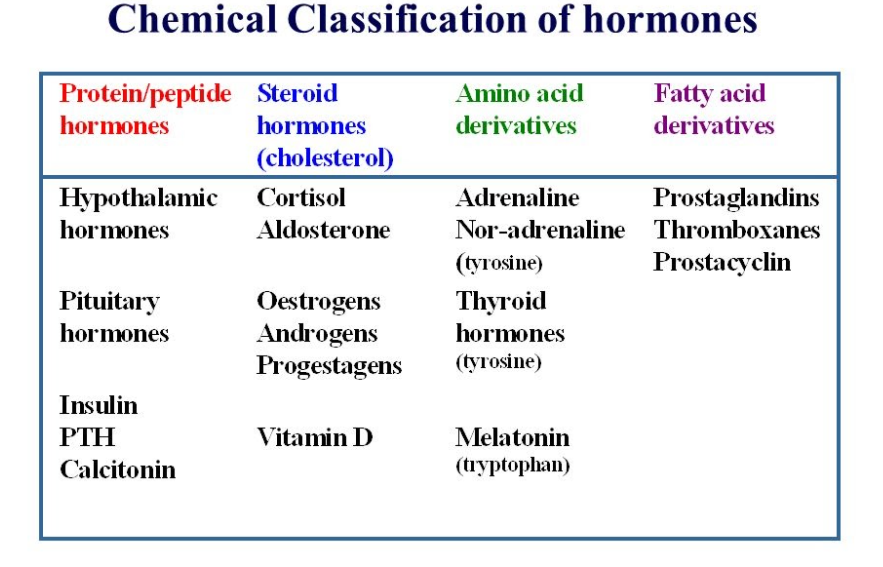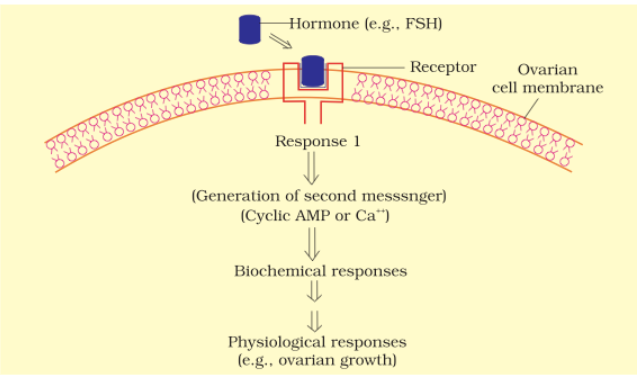CHEMICAL COORDINATION AND INTEGRATION for Class 11 BIOLOGY
INTRODUCTION
- The neural system and the endocrine system jointly coordinate and regulate the physiological functions in the body.The neural system and the endocrine system jointly coordinate and regulate the physiological functions in the body.
- The neural coordination is fast, very exact and short lived, whereas chemical coordination is usually slow, widespread and long lasting.
- All cells of our body are not innervated by nerve fibres but the cellular function need to be continuously regulated so a special kind coordination and integration has to be provided. This function is carried out by the endocrine system.
- The branch of biology which deals with the study of the endocrine system and its physiology is known as "Endocrinology".
- ‘‘Thomas Addison’’ is known as the father of Endocrinology.
- Endocrine glands pour their secretion directly into blood. These glands lack ducts, so these glands are called ductless glands. Whereas the gland with duct is called exocrine gland which secretes enzymes etc.
- Non-organised endocrine gland : Where hormone producing cells are present in scattered form called non-organised or diffused endocrine tissue.
-Example : Heart, Liver, Kidney, Gastrointestinal tract.
INTRODUCTION
- The neural system and the endocrine system jointly coordinate and regulate the physiological functions in the body.The neural system and the endocrine system jointly coordinate and regulate the physiological functions in the body.
- The neural coordination is fast, very exact and short lived, whereas chemical coordination is usually slow, widespread and long lasting.
- All cells of our body are not innervated by nerve fibres but the cellular function need to be continuously regulated so a special kind coordination and integration has to be provided. This function is carried out by the endocrine system.
- The branch of biology which deals with the study of the endocrine system and its physiology is known as "Endocrinology".
- ‘‘Thomas Addison’’ is known as the father of Endocrinology.
- Endocrine glands pour their secretion directly into blood. These glands lack ducts, so these glands are called ductless glands. Whereas the gland with duct is called exocrine gland which secretes enzymes etc.
- Non-organised endocrine gland : Where hormone producing cells are present in scattered form called non-organised or diffused endocrine tissue.
-Example : Heart, Liver, Kidney, Gastrointestinal tract.
ENDOCRINE GLANDS AND HORMONES
- Endocrine glands lack ducts and are hence called ductless glands. Their secretions are called hormones. The word hormone means “To excite.”
- The classical definition of hormone as a chemical produced by endocrine glands and released into the blood and transported to a distantly located target organ has current scientific definition as follows: Hormones are non-nutrient chemicals which act as intracellular messengers and are produced in trace amounts.


ENDOCRINE GLANDS AND HORMONES
- Endocrine glands lack ducts and are hence called ductless glands. Their secretions are called hormones. The word hormone means “To excite.”
- The classical definition of hormone as a chemical produced by endocrine glands and released into the blood and transported to a distantly located target organ has current scientific definition as follows: Hormones are non-nutrient chemicals which act as intracellular messengers and are produced in trace amounts.


CLASSIFICATION OF HORMONES ON THE BASIS OF CHEMICAL NATURE
CLASSIFICATION OF HORMONES ON THE BASIS OF CHEMICAL NATURE
HUMAN ENDOCRINE SYSTEM
- The endocrine glands and hormone producing diffused tissues/cells located in different parts of our body constitute the endocrine system. Pituitary, pineal, thyroid, adrenal, pancreas, parathyroid, thymus and gonads (testis in males and ovary in females) are the organised endocrine bodies in our body.
-In addition to these, some other organs, e.g., gastrointestinal tract, liver, kidney, heart also produce hormones.
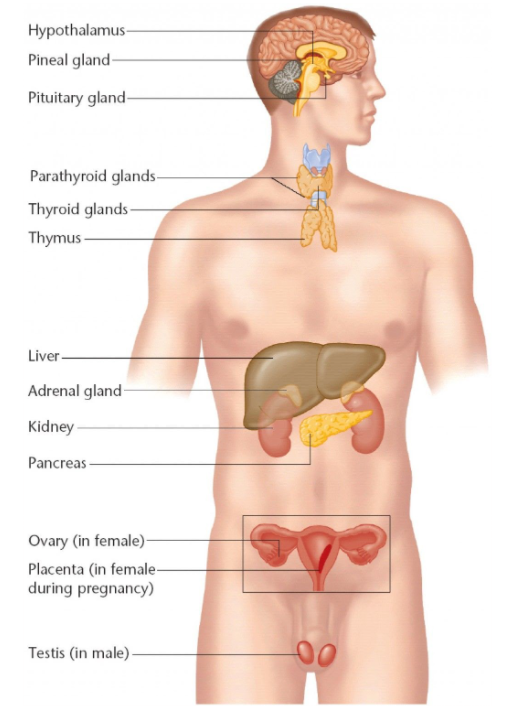
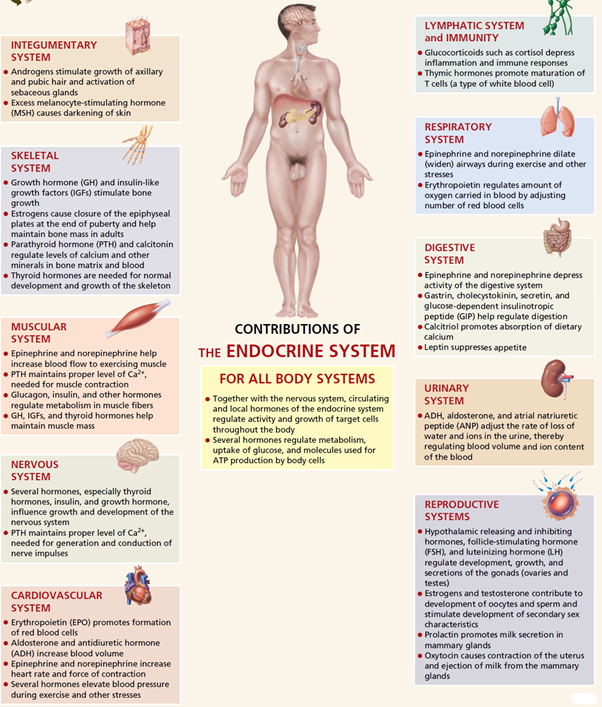
HUMAN ENDOCRINE SYSTEM
- The endocrine glands and hormone producing diffused tissues/cells located in different parts of our body constitute the endocrine system. Pituitary, pineal, thyroid, adrenal, pancreas, parathyroid, thymus and gonads (testis in males and ovary in females) are the organised endocrine bodies in our body.
-In addition to these, some other organs, e.g., gastrointestinal tract, liver, kidney, heart also produce hormones.


Hypothalamus
- Hypothalamus ke hormones anterior pituitary par act karte hai and iske response me anterior pituitary fir further functions jaise ke particular hormone ka production karna - aisey kaam karta hai. Posterior pituitary is under the direct neural regulation via hypothalamus.
- Hypothalamus, thyrotropin releasing hormone (TRH) secrete karta hai jiske karan anterior pituitary se TSH secrete kiya jayega.
- Growth hormone releasing hormone (GHRH) - stimulates release of growth hormone. Issi ko somatocrinin bhi kehte hai.
- Growth hormone inhibiting hormone/somatostatin - inhibits release of growth hormone.
- Gonadotropin releasing hormone/GnRH - stimulates release of LH and FSH
- Prolactin releasing hormone/PRH : stimulates prolactin release.
- Prolactin inhibiting hormone : inhibits prolactin release.
- Adrenocorticotropic hormone releasing hormone : stimulates release of adrenocorticotropic hormone.
- Melanocyte stimulating hormone releasing hormone / MRH ; stimulates release of melanocyte stimulating hormone.
- Melanocyte stimulating hormone inhibiting hormone/ MIH - inhibits the release of melanocyte stimulating hormone.
Hypothalamic Hormones
Hypothalamus
- Hypothalamus ke hormones anterior pituitary par act karte hai and iske response me anterior pituitary fir further functions jaise ke particular hormone ka production karna - aisey kaam karta hai. Posterior pituitary is under the direct neural regulation via hypothalamus.
- Hypothalamus, thyrotropin releasing hormone (TRH) secrete karta hai jiske karan anterior pituitary se TSH secrete kiya jayega.
- Growth hormone releasing hormone (GHRH) - stimulates release of growth hormone. Issi ko somatocrinin bhi kehte hai.
- Growth hormone inhibiting hormone/somatostatin - inhibits release of growth hormone.
- Gonadotropin releasing hormone/GnRH - stimulates release of LH and FSH
- Prolactin releasing hormone/PRH : stimulates prolactin release.
- Prolactin inhibiting hormone : inhibits prolactin release.
- Adrenocorticotropic hormone releasing hormone : stimulates release of adrenocorticotropic hormone.
- Melanocyte stimulating hormone releasing hormone / MRH ; stimulates release of melanocyte stimulating hormone.
- Melanocyte stimulating hormone inhibiting hormone/ MIH - inhibits the release of melanocyte stimulating hormone.
Hypothalamic Hormones
HYPOTHALAMUS
- The hypothalamus is the basal part of diencephalon, forebrain and it regulates a wide spectrum of body functions.
- It contains several groups of neurosecretory cells called nuclei which produce hormones.
- These hormones regulate the synthesis and secretion of pituitary hormones.
- However, the hormones produced by hypothalamus are of two types, the releasing hormones (which stimulate secretion of pituitary hormones) and the inhibiting hormones (which inhibit secretions of pituitary hormones).
- For example a hypothalamic hormone called Gonadotropin releasing hormone (GnRH) stimulates the pituitary synthesis and release of gonadotropins. On the other hand, somatostatin from the hypothalamus inhibits the release of growth hormone from the pituitary.
- These hormones originating in the hypothalamic neurons, pass through axons and are released from their nerve endings. These hormones reach the pituitary gland through a portal circulatory system and regulate the functions of the anterior pituitary.
- The posterior pituitary is under the direct neural regulation of the hypothalamus.
HYPOTHALAMUS
- The hypothalamus is the basal part of diencephalon, forebrain and it regulates a wide spectrum of body functions.
- It contains several groups of neurosecretory cells called nuclei which produce hormones.
- These hormones regulate the synthesis and secretion of pituitary hormones.
- However, the hormones produced by hypothalamus are of two types, the releasing hormones (which stimulate secretion of pituitary hormones) and the inhibiting hormones (which inhibit secretions of pituitary hormones).
- For example a hypothalamic hormone called Gonadotropin releasing hormone (GnRH) stimulates the pituitary synthesis and release of gonadotropins. On the other hand, somatostatin from the hypothalamus inhibits the release of growth hormone from the pituitary.
- These hormones originating in the hypothalamic neurons, pass through axons and are released from their nerve endings. These hormones reach the pituitary gland through a portal circulatory system and regulate the functions of the anterior pituitary.
- The posterior pituitary is under the direct neural regulation of the hypothalamus.
Pituitary Gland
- Pituitary gland, infundibulum naam ki stalk ke jariye hypothalamus se connected hota hai and it rests in the depression of sphenoid bone. Sphenoid bone me wo depression ya jagah jisme pituitary situated hai ussi ko sella turcica bola jata hai.
- Anterior pituitary/ Adenohypophysis/Pars Distalis : larger segment hai jo bahut sare hormones produce karta hai jinko hum abhi padhenge.
- Posterior pituitary/ Neurohypophysis/ Pars Nervosa : smaller part hai jo hypothalamus me synthesize kare gaye 2 hormones ko store and release karta hai.Dhyaan rakhna ki yeah 2 hormone posterior pituitary ne synthesize nahi kiye hai.
- A third region of the pituitary gland called the pars intermedia atrophies during human fetal development and ceases to exist as a separate lobe in adults.
- Thyroid stimulating hormone/TSH - yeah thyroid gland pe act karta hai and thyroid gland iske respone me thyroid hormones banana shuru karta hai so TSH controls the secretions and other activities of the thyroid gland.
- Adrenocorticotropic hormone : adrenal cortex pe act karta hai and then adrenal cortex hormones synthesize karega.
- Melanocyte stimulating hormone : skin me melanocytes naam ke cells iss hormone ka target hai and yeah cells is hormone ke response me melanin naam ka pigment synthesize karte hai.
- Prolactin : mammary glands pe act karta hai and mammary glands iske response me milk produce karna shuru karte hai.
- FSH : yeah males me spermatogenesis and females me ovarian follicles ki growth stimulate karta hai.
- LH : yeah males ke testes me interstitial cells pe acts karta hai jiske response me yeah cells testosterone synthesize karte hai and females me ovulation ke liye responsible hai.
- Human growth hormone - overall growth ke liye responsible hai.
- Oxytocin : uterus ki muscles ka contraction stimulate karta hai and milk ejection ke liye responsible hai.
- Antidiuretic hormone/ADH/Vasopressin : urine production ke time water ka reabsorption stimulate karta hai, yeah vasoconstrictor bhi hai yani ki blood vessels ki constriction karwata hai hence BP badhata hai.
- GH ki excess secretion acromegaly cause karti hai vahi iski deficiency me dwarfism naam ki bimari hoti hai.
Anatomically and functionally iske 3 parts hai :
Anterior Pituitary Hormones :
Anterior pituitary 7 hormones synthesize and secrete karta hai :
→ FSH and LH both act on the gonads (testes and ovaries). In men, they stimulate the testes to produce sperm and to secrete testosterone. In women, they stimulate the ovaries to mature oocytes (eggs) and to secrete estrogens and progesterone.
Neurohypophysis 2 stored hormones secrete karta hai :
Pituitary Gland
- Pituitary gland, infundibulum naam ki stalk ke jariye hypothalamus se connected hota hai and it rests in the depression of sphenoid bone. Sphenoid bone me wo depression ya jagah jisme pituitary situated hai ussi ko sella turcica bola jata hai.
- Anterior pituitary/ Adenohypophysis/Pars Distalis : larger segment hai jo bahut sare hormones produce karta hai jinko hum abhi padhenge.
- Posterior pituitary/ Neurohypophysis/ Pars Nervosa : smaller part hai jo hypothalamus me synthesize kare gaye 2 hormones ko store and release karta hai.Dhyaan rakhna ki yeah 2 hormone posterior pituitary ne synthesize nahi kiye hai.
- A third region of the pituitary gland called the pars intermedia atrophies during human fetal development and ceases to exist as a separate lobe in adults.
- Thyroid stimulating hormone/TSH - yeah thyroid gland pe act karta hai and thyroid gland iske respone me thyroid hormones banana shuru karta hai so TSH controls the secretions and other activities of the thyroid gland.
- Adrenocorticotropic hormone : adrenal cortex pe act karta hai and then adrenal cortex hormones synthesize karega.
- Melanocyte stimulating hormone : skin me melanocytes naam ke cells iss hormone ka target hai and yeah cells is hormone ke response me melanin naam ka pigment synthesize karte hai.
- Prolactin : mammary glands pe act karta hai and mammary glands iske response me milk produce karna shuru karte hai.
- FSH : yeah males me spermatogenesis and females me ovarian follicles ki growth stimulate karta hai.
- LH : yeah males ke testes me interstitial cells pe acts karta hai jiske response me yeah cells testosterone synthesize karte hai and females me ovulation ke liye responsible hai.
- Human growth hormone - overall growth ke liye responsible hai.
- Oxytocin : uterus ki muscles ka contraction stimulate karta hai and milk ejection ke liye responsible hai.
- Antidiuretic hormone/ADH/Vasopressin : urine production ke time water ka reabsorption stimulate karta hai, yeah vasoconstrictor bhi hai yani ki blood vessels ki constriction karwata hai hence BP badhata hai.
- GH ki excess secretion acromegaly cause karti hai vahi iski deficiency me dwarfism naam ki bimari hoti hai.
Anatomically and functionally iske 3 parts hai :
Anterior Pituitary Hormones :
Anterior pituitary 7 hormones synthesize and secrete karta hai :
→ FSH and LH both act on the gonads (testes and ovaries). In men, they stimulate the testes to produce sperm and to secrete testosterone. In women, they stimulate the ovaries to mature oocytes (eggs) and to secrete estrogens and progesterone.
Neurohypophysis 2 stored hormones secrete karta hai :
PITUITARY GLAND
- The pituitary gland is located in a bony cavity called sella turcica and is attached to the hypothalamus by a stalk.
- It is divided anatomically into an adenohypophysis and a neurohypophysis.
- Adenohypophysis consists of two portions, pars distalis and pars intermedia.
- The pars distalis region of pituitary, commonly called anterior pituitary, produces :
- → Growth hormone (GH), → Prolactin (PRL), → Thyroid stimulating hormone (TSH), → Adrenocorticotropic hormone (ACTH), → Luteinizing hormone (LH) and → Follicle stimulating hormone (FSH).
- Pars intermedia secretes only one hormone called Melanocyte stimulating hormone (MSH).
- Neurohypophysis (pars nervosa) also known as posterior pituitary, stores and releases two hormones called Oxytocin and Vasopressin, which are actually synthesised by the hypothalamus and are transported axonally to neurohypophysis.
- Prolactin regulates the growth of the mammary glands and formation of milk in them.
- TSH stimulates the synthesis and secretion of thyroid hormones from the thyroid gland.
- ACTH stimulates the synthesis and secretion of steroid hormones called glucocorticoids from the adrenal cortex.
- LH and FSH stimulate gonadal activity and hence are called gonadotropins.
- In males, LH stimulates the synthesis and secretion of hormones called androgens from testis. In males, FSH and androgens regulate spermatogenesis.
- In females, LH induces ovulation of fully mature follicles (graafian follicles) and maintains the corpus luteum, formed from the remnants of the graafian follicles after ovulation. FSH stimulates growth and development of the ovarian follicles in females.
- MSH acts on the melanocytes (melanin containing cells) and regulates pigmentation of the skin.
- Oxytocin acts on the smooth muscles of our body and stimulates their contraction. In females, it stimulates a vigorous contraction of the uterus at the time of child birth, and milk ejection from the mammary gland.
- Vasopressin acts mainly at the kidney and stimulates reabsorption of water and electrolytes by the distal tubules and thereby reduces loss of water through urine (diuresis). Hence, it is also called as antidiuretic hormone (ADH).
- An impairment affecting synthesis or release of ADH results in a diminished ability of the kidney to conserve water leading to water loss and dehydration. This condition is known as Diabetes Insipidus.
- Gigantism - Over-secretion of GH from childhood stimulates abnormal growth of the body leading to gigantism. It causes excessive growth of all body parts, resulting into symmetrically giant body.
- Dwarfisms - Low secretion of GH results in stunted growth resulting in pituitary dwarfism.
- Acromegaly- Excess secretion of growth hormone in adults especially in middle age can result in severe disfigurement (especially of the face) called Acromegaly, which may lead to serious complications, and premature death if unchecked. The disease is hard to diagnose in the early stages and often goes undetected for many years, until changes in external features become noticeable.

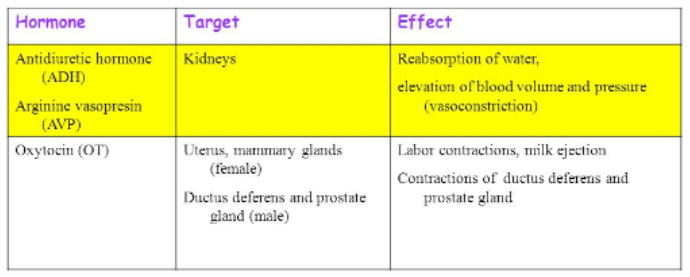
PITUITARY DISORDERS
PITUITARY GLAND
- The pituitary gland is located in a bony cavity called sella turcica and is attached to the hypothalamus by a stalk.
- It is divided anatomically into an adenohypophysis and a neurohypophysis.
- Adenohypophysis consists of two portions, pars distalis and pars intermedia.
- The pars distalis region of pituitary, commonly called anterior pituitary, produces :
- → Growth hormone (GH), → Prolactin (PRL), → Thyroid stimulating hormone (TSH), → Adrenocorticotropic hormone (ACTH), → Luteinizing hormone (LH) and → Follicle stimulating hormone (FSH).
- Pars intermedia secretes only one hormone called Melanocyte stimulating hormone (MSH).
- Neurohypophysis (pars nervosa) also known as posterior pituitary, stores and releases two hormones called Oxytocin and Vasopressin, which are actually synthesised by the hypothalamus and are transported axonally to neurohypophysis.
- Prolactin regulates the growth of the mammary glands and formation of milk in them.
- TSH stimulates the synthesis and secretion of thyroid hormones from the thyroid gland.
- ACTH stimulates the synthesis and secretion of steroid hormones called glucocorticoids from the adrenal cortex.
- LH and FSH stimulate gonadal activity and hence are called gonadotropins.
- In males, LH stimulates the synthesis and secretion of hormones called androgens from testis. In males, FSH and androgens regulate spermatogenesis.
- In females, LH induces ovulation of fully mature follicles (graafian follicles) and maintains the corpus luteum, formed from the remnants of the graafian follicles after ovulation. FSH stimulates growth and development of the ovarian follicles in females.
- MSH acts on the melanocytes (melanin containing cells) and regulates pigmentation of the skin.
- Oxytocin acts on the smooth muscles of our body and stimulates their contraction. In females, it stimulates a vigorous contraction of the uterus at the time of child birth, and milk ejection from the mammary gland.
- Vasopressin acts mainly at the kidney and stimulates reabsorption of water and electrolytes by the distal tubules and thereby reduces loss of water through urine (diuresis). Hence, it is also called as antidiuretic hormone (ADH).
- An impairment affecting synthesis or release of ADH results in a diminished ability of the kidney to conserve water leading to water loss and dehydration. This condition is known as Diabetes Insipidus.
- Gigantism - Over-secretion of GH from childhood stimulates abnormal growth of the body leading to gigantism. It causes excessive growth of all body parts, resulting into symmetrically giant body.
- Dwarfisms - Low secretion of GH results in stunted growth resulting in pituitary dwarfism.
- Acromegaly- Excess secretion of growth hormone in adults especially in middle age can result in severe disfigurement (especially of the face) called Acromegaly, which may lead to serious complications, and premature death if unchecked. The disease is hard to diagnose in the early stages and often goes undetected for many years, until changes in external features become noticeable.


PITUITARY DISORDERS
Pineal Gland
- Yeah endocrine gland 3rd ventricle ki roof se attached hai and secretes many hormones one of which is melatonin. Melatonin darkness me produce kia jata hai and it induces sleep. Toh yeah hormone basically sleep wake cycle maintain karta hai jiske hum circadian rhythm bhi bolte hai.
- In animals that breed during specific seasons, melatonin inhibits reproductive functions, but it is unclear whether melatonin influences human reproductive function.
Pineal Gland
- Yeah endocrine gland 3rd ventricle ki roof se attached hai and secretes many hormones one of which is melatonin. Melatonin darkness me produce kia jata hai and it induces sleep. Toh yeah hormone basically sleep wake cycle maintain karta hai jiske hum circadian rhythm bhi bolte hai.
- In animals that breed during specific seasons, melatonin inhibits reproductive functions, but it is unclear whether melatonin influences human reproductive function.
THE PINEAL GLAND
- The pineal gland is located on the dorsal side of diencephalon (Epithalamus) of the anterior part of the brain. It is also known as epiphysis cerebri. Pineal body is a part of the brain. It is ectodermal in origin. Pineal secretes a hormone called Melatonin. Melatonin plays a very important role in the regulation of a 24-hour (diurnal) rhythm of our body.
- For example, it helps in maintaining the normal rhythms of sleep-wake cycle, body temperature. In addition, melatonin also influences metabolism, pigmentation, the menstrual cycle as well as our defense capability.
THE PINEAL GLAND
- The pineal gland is located on the dorsal side of diencephalon (Epithalamus) of the anterior part of the brain. It is also known as epiphysis cerebri. Pineal body is a part of the brain. It is ectodermal in origin. Pineal secretes a hormone called Melatonin. Melatonin plays a very important role in the regulation of a 24-hour (diurnal) rhythm of our body.
- For example, it helps in maintaining the normal rhythms of sleep-wake cycle, body temperature. In addition, melatonin also influences metabolism, pigmentation, the menstrual cycle as well as our defense capability.
Thyroid Gland
- Butterfly shaped gland hai jo ki larynx ke neeche situated hai.
- Right and left lobes isthmus ke dwara connected hai.
- Thyroid ko microscope me dekhne par hume chote chote spherical areas dekhne ko milte hai and unko hum thyroid follicles kehte hai. Inhi follicles me follicular cells hote hai jo TSH ki influence me thyroid hormones secrete karte hai.
- Thyroid stimulating hormone ke effect ke under thyroid ki follicles thyroxine/T4 hormone produce karti hai. T4 ko T3 me bhi convert kia jata hai and T3 form jyada potent form hai.
- Tyrosine naam ka amino acid iss hormone ka precursor hai.
- Parafollicular cels (yea cells thyroid follicles me beech me present hote hai.) calcitonin/thyrocalcitonin secrete karte hai jo ki calcium homeostasis maintain karta hai. Calcitonin can decrease the level of calcium in the blood by inhibiting the action of osteoclasts, the cells that break down bone extracellular matrix.
- Thyroxine metabolic rate koregulate karta hai, normal body temperature maintain karne me help karta hai- iski amount badhne se temperature bhi badh jata hai. Frogs me yeah metamorphosis ke liye important hai, mental faculties ki development and erythropoiesis ke liye jaruri hai.
- Less amount me thyroxine ka production hypothyroidism kehlata hai jo ki simple goiter bhi ho sakta hai which occurs due to inadequate supply of dietary iodine ya childern me cretinism and adults me myxoedema ki form me ubharta hai.
- Normal se jyada amount me thyroxine ka product hyperthyroidism kehlata hai which manifests as grave’s disease/exophthalmic goiter.
- Cretinism : characterized by dwarfism, mental retardation, dry skin, pot belly, pigeon chest, thick tongue, prolonged neonatal jaundice, lethargy etc.
- Myxoedema : iska primary main diagnostic feature hai facial and neck region me edema jiske karan vhan ke tissues swell ho jate hai and puffy dikhte hai.
- Grave’s Disease ek autoimmune disorder hai jisme ussi person ki antibodies TSH ko mimic karti hai and thyroid gland produces excess thyroxine hormone. Isme aankhon ke peeche swelling hojati hai jiske karan aankhein bahar ki taraf protrude karti hai and isiliye isko exophthalmic goiter bhi bolte hai.
- Thiourea antithyroid hai toh iska use frogs me metamorphosis ko rok deta hai.
- Hashimoto’s disease me bhi diseases person aisi antibodies banata hai jo thyroid gland ke tissue ke destruction ke liye responsible hai and the person suffers from hypothyroidism.
Thyroid Gland
- Butterfly shaped gland hai jo ki larynx ke neeche situated hai.
- Right and left lobes isthmus ke dwara connected hai.
- Thyroid ko microscope me dekhne par hume chote chote spherical areas dekhne ko milte hai and unko hum thyroid follicles kehte hai. Inhi follicles me follicular cells hote hai jo TSH ki influence me thyroid hormones secrete karte hai.
- Thyroid stimulating hormone ke effect ke under thyroid ki follicles thyroxine/T4 hormone produce karti hai. T4 ko T3 me bhi convert kia jata hai and T3 form jyada potent form hai.
- Tyrosine naam ka amino acid iss hormone ka precursor hai.
- Parafollicular cels (yea cells thyroid follicles me beech me present hote hai.) calcitonin/thyrocalcitonin secrete karte hai jo ki calcium homeostasis maintain karta hai. Calcitonin can decrease the level of calcium in the blood by inhibiting the action of osteoclasts, the cells that break down bone extracellular matrix.
- Thyroxine metabolic rate koregulate karta hai, normal body temperature maintain karne me help karta hai- iski amount badhne se temperature bhi badh jata hai. Frogs me yeah metamorphosis ke liye important hai, mental faculties ki development and erythropoiesis ke liye jaruri hai.
- Less amount me thyroxine ka production hypothyroidism kehlata hai jo ki simple goiter bhi ho sakta hai which occurs due to inadequate supply of dietary iodine ya childern me cretinism and adults me myxoedema ki form me ubharta hai.
- Normal se jyada amount me thyroxine ka product hyperthyroidism kehlata hai which manifests as grave’s disease/exophthalmic goiter.
- Cretinism : characterized by dwarfism, mental retardation, dry skin, pot belly, pigeon chest, thick tongue, prolonged neonatal jaundice, lethargy etc.
- Myxoedema : iska primary main diagnostic feature hai facial and neck region me edema jiske karan vhan ke tissues swell ho jate hai and puffy dikhte hai.
- Grave’s Disease ek autoimmune disorder hai jisme ussi person ki antibodies TSH ko mimic karti hai and thyroid gland produces excess thyroxine hormone. Isme aankhon ke peeche swelling hojati hai jiske karan aankhein bahar ki taraf protrude karti hai and isiliye isko exophthalmic goiter bhi bolte hai.
- Thiourea antithyroid hai toh iska use frogs me metamorphosis ko rok deta hai.
- Hashimoto’s disease me bhi diseases person aisi antibodies banata hai jo thyroid gland ke tissue ke destruction ke liye responsible hai and the person suffers from hypothyroidism.
THYROID GLAND
- The thyroid gland is composed of two lobes which are located on either side of the trachea. Both the lobes are interconnected with a thin flap of connective tissue called isthmus.dorsal side of diencephalon (Epithalamus) of anterior part of brain.
- The thyroid gland is composed of follicles and stromal tissues. Each thyroid follicle is composed of follicular cells, enclosing a cavity.
- These follicular cells synthesise two hormones, tetraiodothyronine or thyroxine (T4 ) and triiodothyronine (T3 ).
- Iodine is essential for the normal rate of hormone synthesis in the thyroid.
- The stroma contains clusters of parafollicular cells or C cells which secrete non iodinated hormone calcitonin or Thyrocalcitonin.
FUNCTIONS OF THYROID HORMONE
- Thyroid hormones play an important role in the regulation of the basal metabolic rate.
- These hormones also support the process of red blood cell formation.
- Thyroid hormones control the metabolism of carbohydrates, proteins and fats.
- Maintenance of water and electrolyte balance is also influenced by thyroid hormones.
- Thyrocalcitonin (TCT) regulates the blood calcium levels.
- They also help in homeothermy and regulate the menstrual cycle and development of CNS.
DISEASES OF THYROID HORMONE
- Deficiency of iodine in our diet results in hypothyroidism and enlargement of the thyroid gland, commonly called goitre. Hypothyroidism during pregnancy causes defective development and maturation of the growing baby leading to stunted growth (cretinism), mental retardation, low intelligence quotient, abnormal skin, deaf-mutism, etc. In adult women, hypothyroidism may cause the menstrual cycle to become irregular.
- Due to cancer of the thyroid gland or due to development of nodules of the thyroid glands, the rate of synthesis and secretion of the thyroid hormones is increased to abnormally high levels leading to a condition called hyperthyroidism which adversely affects the body physiology. Exophthalmic goitre is a form of hyperthyroidism, characterised by enlargement of the thyroid gland, protrusion of the eyeballs, increased basal metabolic rate, and weight loss, also called Graves’ disease.

THYROID GLAND
- The thyroid gland is composed of two lobes which are located on either side of the trachea. Both the lobes are interconnected with a thin flap of connective tissue called isthmus.dorsal side of diencephalon (Epithalamus) of anterior part of brain.
- The thyroid gland is composed of follicles and stromal tissues. Each thyroid follicle is composed of follicular cells, enclosing a cavity.
- These follicular cells synthesise two hormones, tetraiodothyronine or thyroxine (T4 ) and triiodothyronine (T3 ).
- Iodine is essential for the normal rate of hormone synthesis in the thyroid.
- The stroma contains clusters of parafollicular cells or C cells which secrete non iodinated hormone calcitonin or Thyrocalcitonin.
FUNCTIONS OF THYROID HORMONE
- Thyroid hormones play an important role in the regulation of the basal metabolic rate.
- These hormones also support the process of red blood cell formation.
- Thyroid hormones control the metabolism of carbohydrates, proteins and fats.
- Maintenance of water and electrolyte balance is also influenced by thyroid hormones.
- Thyrocalcitonin (TCT) regulates the blood calcium levels.
- They also help in homeothermy and regulate the menstrual cycle and development of CNS.
DISEASES OF THYROID HORMONE
- Deficiency of iodine in our diet results in hypothyroidism and enlargement of the thyroid gland, commonly called goitre. Hypothyroidism during pregnancy causes defective development and maturation of the growing baby leading to stunted growth (cretinism), mental retardation, low intelligence quotient, abnormal skin, deaf-mutism, etc. In adult women, hypothyroidism may cause the menstrual cycle to become irregular.
- Due to cancer of the thyroid gland or due to development of nodules of the thyroid glands, the rate of synthesis and secretion of the thyroid hormones is increased to abnormally high levels leading to a condition called hyperthyroidism which adversely affects the body physiology. Exophthalmic goitre is a form of hyperthyroidism, characterised by enlargement of the thyroid gland, protrusion of the eyeballs, increased basal metabolic rate, and weight loss, also called Graves’ disease.

Parathyroid Gland
- Humans me thyroid ke peeche 4 chote chote oval shaped glands hi parathyroid glands hote hai.
- Yeah parathyroid hormone/PTH/parathormone secrete karte hai which is responsible for increasing calcium concentration in blood plasma and it also increases elimination of phosphate in urine toh phosphate ki concentration ko blood plasma me decrease karta hai.
- Principal actions of PTH : Increases blood Ca2+ and Mg2+ levels and decreases blood HPO42− level; increases bone resorption by osteoclasts; increases Ca2+ reabsorption and HPO42− excretion by kidneys; promotes formation of calcitriol (active form of vitamin D), which increases rate of dietary Ca2+ and Mg2+ absorption.
- PTH ki kami ke karan plasma me calcium ion ki kami hoti hai jiske karan neurons and muscle fibers become depolarised without any stimulus and this leads to muscle twitches, spasms and convolutions. Isko parathyroid tetany bhi bola jata hai.
- PTH ki hypersecretion ke karan bones demineralise hojati hai and they can fracture easily. Bone ka destroyed area cavities develop kar leta hai which will be filled with fibrous tissue isiliye iss condition ko ostitis fibrosa cystica bhi bolte hai.
- Calcium and phosphate metabolism ko maintain karne wala dusra hormone hai calcitonin jiske parafollicular cells secrete karte hai. Parafollicular cells basically thyroid ki follicles ke baahr situated hote hai. Yeah hormone PTH ka antagonistic hai yani ki iski secretion ke karan blood plasma me calcium ki concentration decrease hoti hai. Jab plasma me calcium ions bahut hi kam hoti hai toh kidneys se calcitriol secrete kiya jata hai jo calcium reabsorption ko enhance karta hai.
Parathyroid Gland
- Humans me thyroid ke peeche 4 chote chote oval shaped glands hi parathyroid glands hote hai.
- Yeah parathyroid hormone/PTH/parathormone secrete karte hai which is responsible for increasing calcium concentration in blood plasma and it also increases elimination of phosphate in urine toh phosphate ki concentration ko blood plasma me decrease karta hai.
- Principal actions of PTH : Increases blood Ca2+ and Mg2+ levels and decreases blood HPO42− level; increases bone resorption by osteoclasts; increases Ca2+ reabsorption and HPO42− excretion by kidneys; promotes formation of calcitriol (active form of vitamin D), which increases rate of dietary Ca2+ and Mg2+ absorption.
- PTH ki kami ke karan plasma me calcium ion ki kami hoti hai jiske karan neurons and muscle fibers become depolarised without any stimulus and this leads to muscle twitches, spasms and convolutions. Isko parathyroid tetany bhi bola jata hai.
- PTH ki hypersecretion ke karan bones demineralise hojati hai and they can fracture easily. Bone ka destroyed area cavities develop kar leta hai which will be filled with fibrous tissue isiliye iss condition ko ostitis fibrosa cystica bhi bolte hai.
- Calcium and phosphate metabolism ko maintain karne wala dusra hormone hai calcitonin jiske parafollicular cells secrete karte hai. Parafollicular cells basically thyroid ki follicles ke baahr situated hote hai. Yeah hormone PTH ka antagonistic hai yani ki iski secretion ke karan blood plasma me calcium ki concentration decrease hoti hai. Jab plasma me calcium ions bahut hi kam hoti hai toh kidneys se calcitriol secrete kiya jata hai jo calcium reabsorption ko enhance karta hai.
PARATHYROID GLAND
- In humans, four parathyroid glands are present on the back side of the thyroid gland, one pair each in the two lobes of the thyroid gland.
- The parathyroid glands secrete a peptide hormone called parathyroid hormone (PTH). The secretion of PTH is regulated by the circulating levels of calcium ions.
- Parathyroid hormone (PTH) increases the Ca2+ levels in the blood. PTH acts on bones and stimulates the process of bone resorption (dissolution/ demineralisation).
- PTH also stimulates reabsorption of Ca2+ by the renal tubules and increases Ca2+ absorption from the digested food. It is, thus, clear that PTH is a hypercalcemic hormone, i.e., it increases the blood Ca2+ levels. Along with TCT, it plays a significant role in calcium balance in the body.
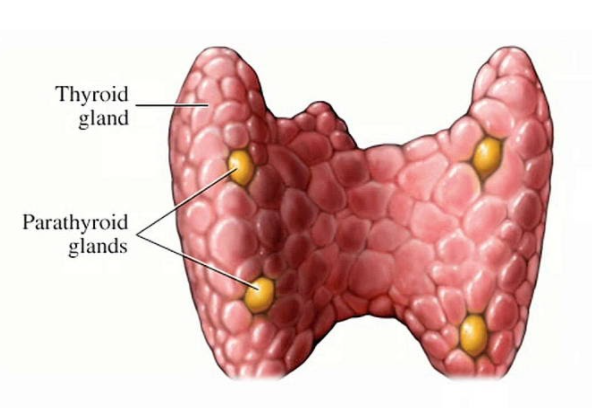

PARATHYROID GLAND
- In humans, four parathyroid glands are present on the back side of the thyroid gland, one pair each in the two lobes of the thyroid gland.
- The parathyroid glands secrete a peptide hormone called parathyroid hormone (PTH). The secretion of PTH is regulated by the circulating levels of calcium ions.
- Parathyroid hormone (PTH) increases the Ca2+ levels in the blood. PTH acts on bones and stimulates the process of bone resorption (dissolution/ demineralisation).
- PTH also stimulates reabsorption of Ca2+ by the renal tubules and increases Ca2+ absorption from the digested food. It is, thus, clear that PTH is a hypercalcemic hormone, i.e., it increases the blood Ca2+ levels. Along with TCT, it plays a significant role in calcium balance in the body.


Adrenal Gland
- Yeah kidneys ke uper located hai and isme 2 regions hai : outer cortex and inner medulla. Cortex region steroid hormones secrete karta hai jo ki 3 main families se belong karte hai : glucocorticoids, mineralcorticoids and sex corticoids. Medulla fight and flight hormones yani ki adrenaline and nor-adrenaline jaise hormones secrete karta hai. Adrenal cortex ka removal animal ke liye fatal hota hai.
- Adrenal cortex ki 3 layers hoti hai : zona glomerulosa - mineralcorticoids secrete karta hai, zona fasciculata glucocorticoids secret karti hai and zona reticulata innermost layer hai jo ki sex corticoids secrete karti hai.
- Zona fasciculata and reticulata are under the control of ACTH hormone from anterior pituitary.
- Mineralocorticoids : principle hormone ADH hai. Yeah hormones sodium, potassium and baki ions ke metabolism ko regulate karte hai.
- Glucocorticoids : Carbohydrates, fats and proteins ke metabolism ko regulate karte hai.
- Sexcorticoids : ex - androstenedione, dehydroepiandrosterone (DHEA)
- Addison's disease : deficiency of glucocorticoids and mineralocorticoids. Symptoms : Skin ka color bronze hojata hai, low blood sugar, low plasma sodium concentration and high plasma potassium concentration.
- Cushing syndrome cortisol (ek glucocorticoid) ke hypersecretion se hote hai. Isme high blood sugar, obesity, wasting of limb muscles, high plasms sodium concentration jaise features dekhe jate hai.
- ADH ke hypersecretion se aldosteronism/conn’s disease hoti hai.
- Females me sex corticoids ki excess secretion ke karan unme male secondary sex characteristics develop hojate hai. Isko adrenal virilism kha jata hai.

Adrenal Gland
- Yeah kidneys ke uper located hai and isme 2 regions hai : outer cortex and inner medulla. Cortex region steroid hormones secrete karta hai jo ki 3 main families se belong karte hai : glucocorticoids, mineralcorticoids and sex corticoids. Medulla fight and flight hormones yani ki adrenaline and nor-adrenaline jaise hormones secrete karta hai. Adrenal cortex ka removal animal ke liye fatal hota hai.
- Adrenal cortex ki 3 layers hoti hai : zona glomerulosa - mineralcorticoids secrete karta hai, zona fasciculata glucocorticoids secret karti hai and zona reticulata innermost layer hai jo ki sex corticoids secrete karti hai.
- Zona fasciculata and reticulata are under the control of ACTH hormone from anterior pituitary.
- Mineralocorticoids : principle hormone ADH hai. Yeah hormones sodium, potassium and baki ions ke metabolism ko regulate karte hai.
- Glucocorticoids : Carbohydrates, fats and proteins ke metabolism ko regulate karte hai.
- Sexcorticoids : ex - androstenedione, dehydroepiandrosterone (DHEA)
- Addison's disease : deficiency of glucocorticoids and mineralocorticoids. Symptoms : Skin ka color bronze hojata hai, low blood sugar, low plasma sodium concentration and high plasma potassium concentration.
- Cushing syndrome cortisol (ek glucocorticoid) ke hypersecretion se hote hai. Isme high blood sugar, obesity, wasting of limb muscles, high plasms sodium concentration jaise features dekhe jate hai.
- ADH ke hypersecretion se aldosteronism/conn’s disease hoti hai.
- Females me sex corticoids ki excess secretion ke karan unme male secondary sex characteristics develop hojate hai. Isko adrenal virilism kha jata hai.

ADRENAL GLAND
- Our body has one pair of adrenal glands, one at the anterior part of each kidney. The gland is composed of two types of tissues.
- The centrally located tissue is called the adrenal medulla, and outside this lies the adrenal cortex.
DISORDERS OF ADRENAL GLAND
- Underproduction of hormones by the adrenal cortex alters carbohydrate metabolism causing acute weakness and fatigue leading to a disease called Addison’s disease.Symptoms are low blood sugar, low plasma Na+ , High K+ plasma, increased urinary Na+, Nausea, vomiting, diarrhoea etc.
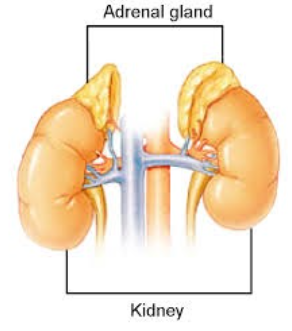
Hormones of adrenal cortex


ADRENAL GLAND
- Our body has one pair of adrenal glands, one at the anterior part of each kidney. The gland is composed of two types of tissues.
- The centrally located tissue is called the adrenal medulla, and outside this lies the adrenal cortex.
DISORDERS OF ADRENAL GLAND
- Underproduction of hormones by the adrenal cortex alters carbohydrate metabolism causing acute weakness and fatigue leading to a disease called Addison’s disease.Symptoms are low blood sugar, low plasma Na+ , High K+ plasma, increased urinary Na+, Nausea, vomiting, diarrhoea etc.

Hormones of adrenal cortex


Thymus
- Iss gland ka maximum size 15 yrs age pe hota hai and uske baad yeah degenerate karne lag jata hai.
- Outer region cortex kehlata hai which is densely packed with T lymphocytes and inner medulla wale region me T cells kam hote hai. Yeah T lymphocytes ko education deta hai ki konse self antigens jinpe attack nahi karna and baki se non-self antigens honge jinpe attack karna hai.
- The hormones produced by the thymus—thymosin, thymic humoral factor (THF), thymic factor (TF), and thymopoietin —promote the maturation of T cells (a type of white blood cell that destroys microbes and foreign substances) and may retard the aging process.
Thymus
- Iss gland ka maximum size 15 yrs age pe hota hai and uske baad yeah degenerate karne lag jata hai.
- Outer region cortex kehlata hai which is densely packed with T lymphocytes and inner medulla wale region me T cells kam hote hai. Yeah T lymphocytes ko education deta hai ki konse self antigens jinpe attack nahi karna and baki se non-self antigens honge jinpe attack karna hai.
- The hormones produced by the thymus—thymosin, thymic humoral factor (THF), thymic factor (TF), and thymopoietin —promote the maturation of T cells (a type of white blood cell that destroys microbes and foreign substances) and may retard the aging process.
THYMUS
- The thymus gland is a lobular structure located between lungs behind the sternum on the ventral side of the aorta.
- The thymus plays a major role in the development of the immune system. This gland secretes the peptide hormones called thymosins.
- Thymosins play a major role in the differentiation of T-lymphocytes, which provide cell-mediated immunity.
- In addition, thymosins also promote production of antibodies to provide humoral immunity.
- It plays a major role in the development of the immune system.
FUNCTIONS OF THYMOSINS
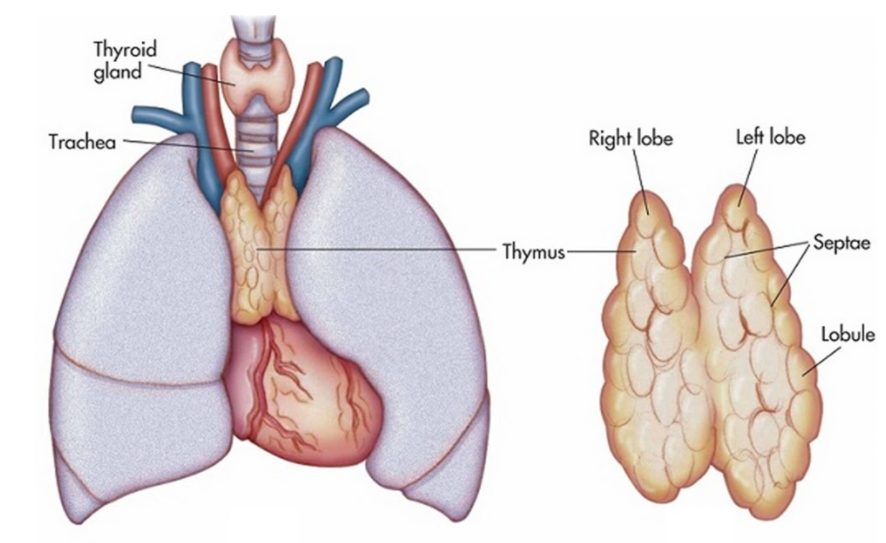
Thymus is degenerated in old individuals resulting in a decreased production of thymosins. As a result, the immune responses of old persons become weak.
THYMUS
- The thymus gland is a lobular structure located between lungs behind the sternum on the ventral side of the aorta.
- The thymus plays a major role in the development of the immune system. This gland secretes the peptide hormones called thymosins.
- Thymosins play a major role in the differentiation of T-lymphocytes, which provide cell-mediated immunity.
- In addition, thymosins also promote production of antibodies to provide humoral immunity.
- It plays a major role in the development of the immune system.
FUNCTIONS OF THYMOSINS

Thymus is degenerated in old individuals resulting in a decreased production of thymosins. As a result, the immune responses of old persons become weak.
Pancreas
- Yeah ek mixed gland hai yani ki isme endocrine and exocrine dono parts hai. Nearly 99% exocrine cells clusters me arranged hai jinko hum acini kehte hai. Yeah digestive enzymes produce karte hai. inhi acini ke beech me endocrine tissue ke chote chote clusters hote hai jinko hum pancreatic islets kehte hai ya fir islets of langerhans.
- Pancreatic islets me different types ke cell different hormones secrete karte hai :
- Alpha cells glucagon naam ka hormone produce karte hai. Functions : Raises blood glucose level by accelerating breakdown of glycogen into glucose in liver (glycogenolysis), converting other nutrients into glucose in liver (gluconeogenesis), and releasing glucose into blood.
- Beta cells insulin hormone produce karte hai. Functions : Lowers blood glucose level by accelerating transport of glucose into cells, converting glucose into glycogen (glycogenesis), and decreasing glycogenolysis and gluconeogenesis; increases lipogenesis and stimulates protein synthesis.
- Delta cells somatostatin secrete karte hai. Somatostatin acts in a paracrine manner to inhibit both insulin and glucagon release from neighboring beta and alpha cells. It may also act as a circulating hormone to slow absorption of nutrients from the gastrointestinal tract. In addition, somatostatin inhibits the secretion of growth hormone.
- F cells pancreatic polypeptide secrete karte hai. It inhibits somatostatin secretion, gallbladder contraction, and secretion of digestive enzymes by the pancreas.
Pancreas
- Yeah ek mixed gland hai yani ki isme endocrine and exocrine dono parts hai. Nearly 99% exocrine cells clusters me arranged hai jinko hum acini kehte hai. Yeah digestive enzymes produce karte hai. inhi acini ke beech me endocrine tissue ke chote chote clusters hote hai jinko hum pancreatic islets kehte hai ya fir islets of langerhans.
- Pancreatic islets me different types ke cell different hormones secrete karte hai :
- Alpha cells glucagon naam ka hormone produce karte hai. Functions : Raises blood glucose level by accelerating breakdown of glycogen into glucose in liver (glycogenolysis), converting other nutrients into glucose in liver (gluconeogenesis), and releasing glucose into blood.
- Beta cells insulin hormone produce karte hai. Functions : Lowers blood glucose level by accelerating transport of glucose into cells, converting glucose into glycogen (glycogenesis), and decreasing glycogenolysis and gluconeogenesis; increases lipogenesis and stimulates protein synthesis.
- Delta cells somatostatin secrete karte hai. Somatostatin acts in a paracrine manner to inhibit both insulin and glucagon release from neighboring beta and alpha cells. It may also act as a circulating hormone to slow absorption of nutrients from the gastrointestinal tract. In addition, somatostatin inhibits the secretion of growth hormone.
- F cells pancreatic polypeptide secrete karte hai. It inhibits somatostatin secretion, gallbladder contraction, and secretion of digestive enzymes by the pancreas.
PANCREAS
- Pancreas is a composite gland which acts as both exocrine and endocrine gland, situated in the concavity formed by duodenum just behind the stomach.
- The endocrine pancreas consists of ‘Islets of Langerhans’. There are about 1 to 2 million Islets of Langerhans in a normal human pancreas representing only 1 to 2 percent of the pancreatic tissue. The two main types of cells in the Islet of Langerhans are called α-cells and β-cells.
- Diabetes mellitus can be due to
- Insulin deficiency(Insulin dependent diabetes mellitus-IDDM).
- Insulin resistance(non-insulin dependent diabetes mellitus-NIDDM).
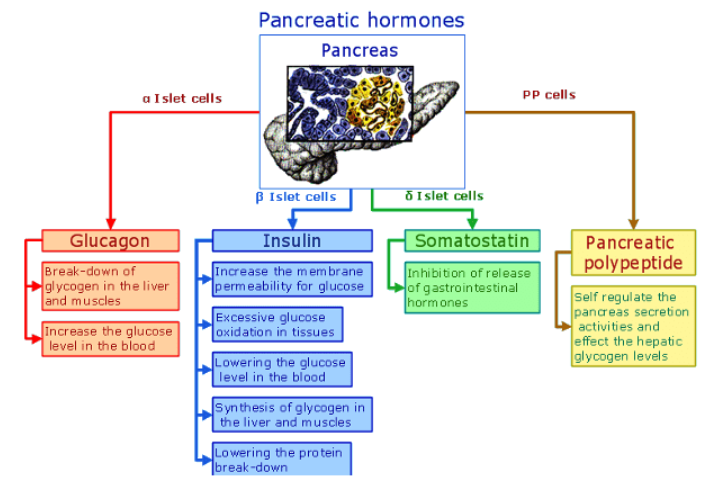
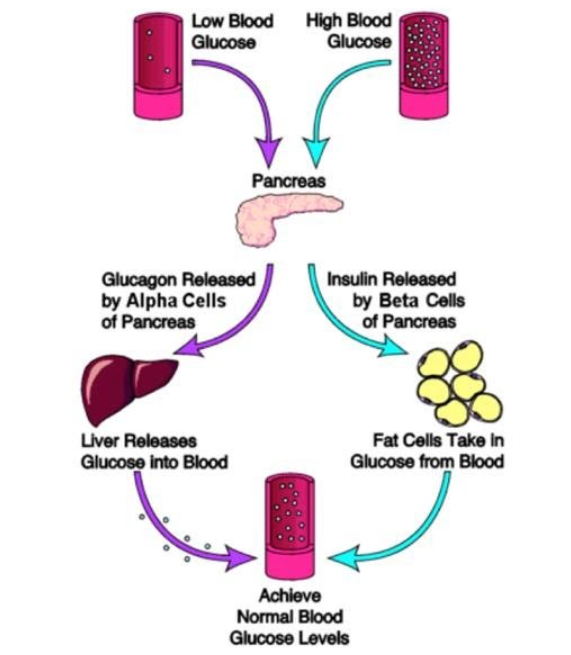
PANCREATIC DISORDER

PANCREAS
- Pancreas is a composite gland which acts as both exocrine and endocrine gland, situated in the concavity formed by duodenum just behind the stomach.
- The endocrine pancreas consists of ‘Islets of Langerhans’. There are about 1 to 2 million Islets of Langerhans in a normal human pancreas representing only 1 to 2 percent of the pancreatic tissue. The two main types of cells in the Islet of Langerhans are called α-cells and β-cells.
- Diabetes mellitus can be due to
- Insulin deficiency(Insulin dependent diabetes mellitus-IDDM).
- Insulin resistance(non-insulin dependent diabetes mellitus-NIDDM).


PANCREATIC DISORDER

Testis & Ovaries
- Ovarian Hormones :
- Estrogen & Progesterone : Together with gonadotropic hormones of anterior pituitary, they regulate female reproductive cycle, maintain pregnancy, prepare mammary glands for lactation, and promote development and maintenance of female secondary sex characteristics.
- Relaxin : Increases flexibility of pubic symphysis during pregnancy; helps dilate uterine cervix during labor and delivery.
- Inhibin : Inhibits secretion of FSH from anterior pituitary.
- Testosterone : Stimulates descent of testes before birth; regulates sperm production; promotes development and maintenance of male secondary sex characteristics.
- Inhibin : Inhibits secretion of FSH from anterior pituitary.
Testis :
Testis & Ovaries
- Ovarian Hormones :
- Estrogen & Progesterone : Together with gonadotropic hormones of anterior pituitary, they regulate female reproductive cycle, maintain pregnancy, prepare mammary glands for lactation, and promote development and maintenance of female secondary sex characteristics.
- Relaxin : Increases flexibility of pubic symphysis during pregnancy; helps dilate uterine cervix during labor and delivery.
- Inhibin : Inhibits secretion of FSH from anterior pituitary.
- Testosterone : Stimulates descent of testes before birth; regulates sperm production; promotes development and maintenance of male secondary sex characteristics.
- Inhibin : Inhibits secretion of FSH from anterior pituitary.
Testis :
TESTIS
- A pair of testis is present in the scrotal sac (outside abdomen) of male individuals. Testis performs dual functions as a primary sex organ as well as an endocrine gland. Testis is composed of seminiferous tubules and stromal or interstitial tissue.
- The Leydig cells or interstitial cells, which are present in the intertubular spaces produce a group of hormones called androgens, mainly testosterone.
- Androgens regulate the development, maturation and functions of the male accessory sex organs like epididymis, vas deferens, seminal vesicles, prostate gland, urethra etc.
- These hormones stimulate muscular growth, growth of facial and axillary hair, aggressiveness, low pitch of voice etc.
- Androgens play a major stimulatory role in the process of spermatogenesis (formation of spermatozoa).
- Androgens act on the central neural system and influence the male sexual behaviour (libido). These hormones produce anabolic (synthetic) effects on protein and carbohydrate metabolism.
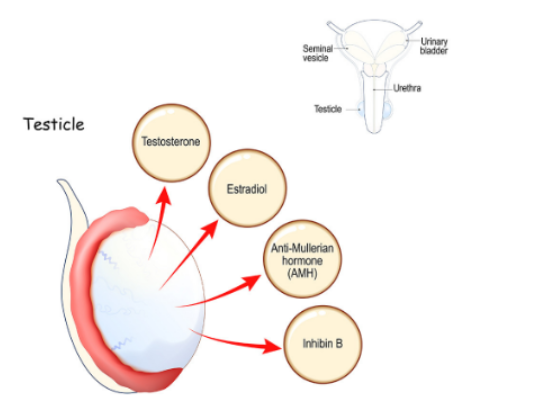
TESTIS
- A pair of testis is present in the scrotal sac (outside abdomen) of male individuals. Testis performs dual functions as a primary sex organ as well as an endocrine gland. Testis is composed of seminiferous tubules and stromal or interstitial tissue.
- The Leydig cells or interstitial cells, which are present in the intertubular spaces produce a group of hormones called androgens, mainly testosterone.
- Androgens regulate the development, maturation and functions of the male accessory sex organs like epididymis, vas deferens, seminal vesicles, prostate gland, urethra etc.
- These hormones stimulate muscular growth, growth of facial and axillary hair, aggressiveness, low pitch of voice etc.
- Androgens play a major stimulatory role in the process of spermatogenesis (formation of spermatozoa).
- Androgens act on the central neural system and influence the male sexual behaviour (libido). These hormones produce anabolic (synthetic) effects on protein and carbohydrate metabolism.

OVARY
- Females have a pair of ovaries located in the abdomen. Ovary is the primary female sex organ which produces one ovum during each menstrual cycle.
- In addition, ovary also produces two groups of steroid hormones called estrogen and progesterone. Ovary is composed of ovarian follicles and stromal tissues.
- The estrogen is synthesised and secreted mainly by the growing ovarian follicles. After ovulation, the ruptured follicle is converted to a structure called corpus luteum, which secretes mainly progesterone.
- Estrogens produce wide ranging actions such as stimulation of growth and activities of female secondary sex organs, development of growing ovarian follicles, appearance of female secondary sex characters (e.g., high pitch of voice, etc.), mammary gland development.
- Estrogens also regulate female sexual behaviour. Progesterone supports pregnancy.
- Progesterone also acts on the mammary glands and stimulates the formation of alveoli (sac-like structures which store milk) and milk secretion.
OVARY
- Females have a pair of ovaries located in the abdomen. Ovary is the primary female sex organ which produces one ovum during each menstrual cycle.
- In addition, ovary also produces two groups of steroid hormones called estrogen and progesterone. Ovary is composed of ovarian follicles and stromal tissues.
- The estrogen is synthesised and secreted mainly by the growing ovarian follicles. After ovulation, the ruptured follicle is converted to a structure called corpus luteum, which secretes mainly progesterone.
- Estrogens produce wide ranging actions such as stimulation of growth and activities of female secondary sex organs, development of growing ovarian follicles, appearance of female secondary sex characters (e.g., high pitch of voice, etc.), mammary gland development.
- Estrogens also regulate female sexual behaviour. Progesterone supports pregnancy.
- Progesterone also acts on the mammary glands and stimulates the formation of alveoli (sac-like structures which store milk) and milk secretion.
HORMONES OF HEART ,KIDNEY AND GASTROINTESTINAL TRACT
- Hormones are also secreted by some tissues which are not endocrine glands. For example,
- The atrial wall of our heart secretes a very important peptide hormone called atrial natriuretic factor (ANF), which decreases blood pressure. When blood pressure is increased, ANF is secreted which causes dilation of the blood vessels. This reduces the blood pressure.
- The juxtaglomerular cells of the kidney produce a peptide hormone called erythropoietin which stimulates erythropoiesis (formation of RBC).
- Endocrine cells present in different parts of the gastro-intestinal tract secrete four major peptide hormones, namely gastrin, secretin, cholecystokinin (CCK) and gastric inhibitory peptide (GIP).
- Gastrin acts on the gastric glands and stimulates the secretion of hydrochloric acid and pepsinogen.
- Secretin acts on the exocrine pancreas and stimulates secretion of water and bicarbonate ions. CCK acts on both pancreas and gallbladder and stimulates the secretion of pancreatic enzymes and bile juice, respectively.
- GIP inhibits gastric secretion and motility.
- Several other non-endocrine tissues secrete hormones called growth factors. These factors are essential for the normal growth of tissues and their repairing/regeneration.
HORMONES OF HEART ,KIDNEY AND GASTROINTESTINAL TRACT
- Hormones are also secreted by some tissues which are not endocrine glands. For example,
- The atrial wall of our heart secretes a very important peptide hormone called atrial natriuretic factor (ANF), which decreases blood pressure. When blood pressure is increased, ANF is secreted which causes dilation of the blood vessels. This reduces the blood pressure.
- The juxtaglomerular cells of the kidney produce a peptide hormone called erythropoietin which stimulates erythropoiesis (formation of RBC).
- Endocrine cells present in different parts of the gastro-intestinal tract secrete four major peptide hormones, namely gastrin, secretin, cholecystokinin (CCK) and gastric inhibitory peptide (GIP).
- Gastrin acts on the gastric glands and stimulates the secretion of hydrochloric acid and pepsinogen.
- Secretin acts on the exocrine pancreas and stimulates secretion of water and bicarbonate ions. CCK acts on both pancreas and gallbladder and stimulates the secretion of pancreatic enzymes and bile juice, respectively.
- GIP inhibits gastric secretion and motility.
- Several other non-endocrine tissues secrete hormones called growth factors. These factors are essential for the normal growth of tissues and their repairing/regeneration.
Mechanism of Action
- Hormones ko hum lipid soluble and water soluble hormones me classify kar sakte hai. Cell membrane lipid bilayer hai toh jo hormones lipid soluble hai wo directly cell me enter kar sakte hai and jo water soluble hormone hai unke liye cell ki membrane pe special receptors present hote hai. Keep this point in mind.
- Lipid soluble hormones me aate hai steroid hormones jaise ki testosterone, aldosterone, cortisol, calcitriol, estrogen, progesterone, androgens vgarah, thyroid hormone (T3 & T4) and nitric oxide jo ki hormone and ek neurotransmitter dono ka role play karta hai.
- Water soluble hormones me amine hormones, peptide hormones and eicosanoids vgarah aate hai. Ex : epinephrine, norepinephrine, dopamine, ADH, oxytocin, prostaglandins etc sab water soluble hai.
- Koi hormone kaise apna action exert karega yeah uss hormone and uske target cell, dono par hi nirbhar karta hai. Yeah bhi possible hai ki ek hi same hormone ka different cells pe different asar dikhe jaise ki insulin hormone ki presence me liver cells toh glycogen synthesis shuru karte hai but adipose cells triglycerides ki synthesis shuru karte hai.
- Water soluble hormones pehle membrane pe located receptors ke sath bind karte hai. Yeah receptors transmembrane proteins hai jinka kuch hissa cytoplasm me extended hota hai. Jab hormone receptor se bind karta hai toh yeah hormone first messenger kehlata hai. Iss binding ke karan cell me new different messengers ki synthesis hoti hai jaise ki Cyclic adenosine monophosphate (cAMP) ki. Inko second messengers bola jata hai. cAMP fir aage chalkar cell me kisi aur molecule ya enzyme ko activate karega jo further kisi dusre substance ko activate karega toh aise kadi se kadi judti jati hai and issi ko hum signaling cascade kehte hai. Iss cascade ke karan cell bahut sare different pathways activate ho sakte hai jaise ki koi gene switch on ho jayega ya ki switch off ho jayega ya koi dusri process cell me shuru hojayegi ya jo chal rhi thi wo inhibit ho jayegi. Toh depending on hormone, target cell, signaling pathway and cascade molecules - cells me bahut tarah ki processes chal jati hai.
- Lipid soluble hormones directly cell me diffuse kar jata hai and cell ke ander ya toh cytoplasm me ya fir nucleus me uss hormone ke receptors hote hai and yeah hormone ussey jakr bind kar jayega. Yeah activated receptor-hormone complex kehlata hai jo gene expression ko alter karta hai - ya toh kisi gene ki transcription activate hogi ya kisi ki transcription off hojati hai toh iss tarah se apna action exert karte hai.
Mechanism of Action
Mechanism of Action
- Hormones ko hum lipid soluble and water soluble hormones me classify kar sakte hai. Cell membrane lipid bilayer hai toh jo hormones lipid soluble hai wo directly cell me enter kar sakte hai and jo water soluble hormone hai unke liye cell ki membrane pe special receptors present hote hai. Keep this point in mind.
- Lipid soluble hormones me aate hai steroid hormones jaise ki testosterone, aldosterone, cortisol, calcitriol, estrogen, progesterone, androgens vgarah, thyroid hormone (T3 & T4) and nitric oxide jo ki hormone and ek neurotransmitter dono ka role play karta hai.
- Water soluble hormones me amine hormones, peptide hormones and eicosanoids vgarah aate hai. Ex : epinephrine, norepinephrine, dopamine, ADH, oxytocin, prostaglandins etc sab water soluble hai.
- Koi hormone kaise apna action exert karega yeah uss hormone and uske target cell, dono par hi nirbhar karta hai. Yeah bhi possible hai ki ek hi same hormone ka different cells pe different asar dikhe jaise ki insulin hormone ki presence me liver cells toh glycogen synthesis shuru karte hai but adipose cells triglycerides ki synthesis shuru karte hai.
- Water soluble hormones pehle membrane pe located receptors ke sath bind karte hai. Yeah receptors transmembrane proteins hai jinka kuch hissa cytoplasm me extended hota hai. Jab hormone receptor se bind karta hai toh yeah hormone first messenger kehlata hai. Iss binding ke karan cell me new different messengers ki synthesis hoti hai jaise ki Cyclic adenosine monophosphate (cAMP) ki. Inko second messengers bola jata hai. cAMP fir aage chalkar cell me kisi aur molecule ya enzyme ko activate karega jo further kisi dusre substance ko activate karega toh aise kadi se kadi judti jati hai and issi ko hum signaling cascade kehte hai. Iss cascade ke karan cell bahut sare different pathways activate ho sakte hai jaise ki koi gene switch on ho jayega ya ki switch off ho jayega ya koi dusri process cell me shuru hojayegi ya jo chal rhi thi wo inhibit ho jayegi. Toh depending on hormone, target cell, signaling pathway and cascade molecules - cells me bahut tarah ki processes chal jati hai.
- Lipid soluble hormones directly cell me diffuse kar jata hai and cell ke ander ya toh cytoplasm me ya fir nucleus me uss hormone ke receptors hote hai and yeah hormone ussey jakr bind kar jayega. Yeah activated receptor-hormone complex kehlata hai jo gene expression ko alter karta hai - ya toh kisi gene ki transcription activate hogi ya kisi ki transcription off hojati hai toh iss tarah se apna action exert karte hai.
Mechanism of Action
MECHANISM OF HORMONE ACTION
- Hormones produce their effects on target tissues by binding to specific proteins called hormone receptors located in the target tissues only.
- Hormone receptors present on the cell membrane of the target cells are called membrane-bound receptors and the receptors present inside the target cell are called intracellular receptors, mostly nuclear receptors (present in the nucleus).
- Binding of a hormone to its receptor leads to the formation of a hormone-receptor complex.
- Each receptor is specific to one hormone only and hence receptors are specific.
- Hormone-Receptor complex formation leads to certain biochemical changes in the target tissue.
- Target tissue metabolism and hence physiological functions are regulated by hormones. On the basis of their chemical nature, hormones can be divided into groups :
- Peptide, polypeptide, protein hormones (e.g., insulin, glucagon, pituitary hormones, hypothalamic hormones, etc.)
- Steroids (e.g., cortisol, testosterone, estradiol and progesterone)
- Iodothyronines (thyroid hormones)
- Amino-acid derivatives (e.g., epinephrine).
- Hormones which interact with membrane-bound receptors normally do not enter the target cell, but generate second messengers (e.g., cyclic AMP, IP3 , Ca++ etc) which in turn regulate cellular metabolism.
- Hormones which interact with intracellular receptors (e.gsteroid hormones, iodothyronines, etc.) mostly regulate gene expression or chromosome function by the interaction of hormone-receptor complex with the genome.
- Cumulative biochemical actions result in physiological and developmental effects.
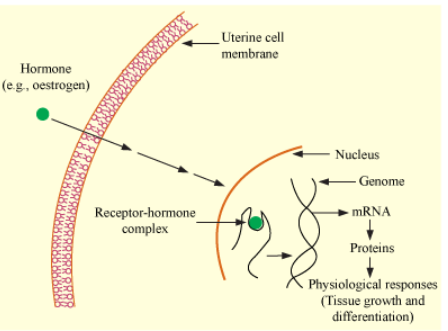
MECHANISM OF HORMONE ACTION
- Hormones produce their effects on target tissues by binding to specific proteins called hormone receptors located in the target tissues only.
- Hormone receptors present on the cell membrane of the target cells are called membrane-bound receptors and the receptors present inside the target cell are called intracellular receptors, mostly nuclear receptors (present in the nucleus).
- Binding of a hormone to its receptor leads to the formation of a hormone-receptor complex.
- Each receptor is specific to one hormone only and hence receptors are specific.
- Hormone-Receptor complex formation leads to certain biochemical changes in the target tissue.
- Target tissue metabolism and hence physiological functions are regulated by hormones. On the basis of their chemical nature, hormones can be divided into groups :
- Peptide, polypeptide, protein hormones (e.g., insulin, glucagon, pituitary hormones, hypothalamic hormones, etc.)
- Steroids (e.g., cortisol, testosterone, estradiol and progesterone)
- Iodothyronines (thyroid hormones)
- Amino-acid derivatives (e.g., epinephrine).
- Hormones which interact with membrane-bound receptors normally do not enter the target cell, but generate second messengers (e.g., cyclic AMP, IP3 , Ca++ etc) which in turn regulate cellular metabolism.
- Hormones which interact with intracellular receptors (e.gsteroid hormones, iodothyronines, etc.) mostly regulate gene expression or chromosome function by the interaction of hormone-receptor complex with the genome.
- Cumulative biochemical actions result in physiological and developmental effects.

Summary
- There are special chemicals which act as hormones and provide chemical coordination, integration and regulation in the human body.
- These hormones regulate metabolism, growth and development of our organs, the endocrine glands or certain cells.
- The endocrine system is composed of hypothalamus, pituitary and pineal, thyroid, adrenal, pancreas, parathyroid, thymus and gonads (testis and ovary).
- In addition to these, some other organs, e.g., gastrointestinal tract, kidney, heart etc., also produce hormones.
- The pituitary gland is divided into three major parts, which are called pars distalis, pars intermedia and pars nervosa.
- Pars distalis produces six trophic hormones. Pars intermedia secretes only one hormone, while pars nervosa (neurohypophysis) secretes two hormones.
- The pituitary hormones regulate the growth and development of somatic tissues and activities of peripheral endocrine glands.
- Pineal gland secretes melatonin, which plays a very important role in the regulation of 24-hour (diurnal) rhythms of our body (e.g., rhythms of sleep and state of being awake, body temperature, etc.).
- The thyroid gland hormones play an important role in the regulation of the basal metabolic rate, development and maturation of the central neural system, erythropoiesis, metabolism of carbohydrates, proteins and fats, and the menstrual cycle.
- Another thyroid hormone, i.e., thyrocalcitonin regulates calcium levels in our blood by decreasing it.
- The parathyroid glands secrete parathyroid hormone (PTH) which increases the blood Ca2+ levels and plays a major role in calcium homeostasis.
- The thymus gland secretes thymosins which play a major role in the differentiation of T-lymphocytes, which provide cell-mediated immunity.
- In addition, thymosins also increase the production of antibodies to provide humoral immunity.
- The adrenal gland is composed of the centrally located adrenal medulla and the outer adrenal cortex.
- The adrenal medulla secretes epinephrine and norepinephrine. These hormones increase alertness, pupillary dilation, piloerection, sweating, heart beat, strength of heart contraction, rate of respiration, glycogenolysis, lipolysis, proteolysis.
- The adrenal cortex secretes glucocorticoids and mineralocorticoids. Glucocorticoids stimulate gluconeogenesis, lipolysis, proteolysis, erythropoiesis, cardio-vascular system, blood pressure, and glomerular filtration rate and inhibit inflammatory reactions by suppressing the immune response.
- Mineralocorticoids regulate water and electrolyte contents of the body.
- The endocrine pancreas secretes glucagon and insulin. Glucagon stimulates glycogenolysis and gluconeogenesis resulting in hyperglycemia. Insulin stimulates cellular glucose uptake and utilisation, and glycogenesis resulting in hypoglycemia.
- Insulin deficiency and/or insulin resistance result in a disease called diabetes mellitus.
- The testis secretes androgens, which stimulate the development, maturation and functions of the male accessory sex organs, appearance of the male secondary sex characters, spermatogenesis, male sexual behaviour, anabolic pathways and erythropoiesis.
- The ovary secretes estrogen and progesterone. Estrogen stimulates growth and development of female accessory sex organs and secondary sex characters.
- Progesterone plays a major role in the maintenance of pregnancy as well as in mammary gland development and lactation.
- The atrial wall of the heart produces an atrial natriuretic factor which decreases the blood pressure.
- Kidney produces erythropoietin which stimulates erythropoiesis.
- The gastrointestinal tract secretes gastrin, secretin, cholecystokinin and gastric inhibitory peptide. These hormones regulate the secretion of digestive juices and help in digestion.
- The neural system and the endocrine system jointly coordinate and regulate the physiological functions in the body.
- The neural coordination is fast, very exact and short lived, whereas chemical coordination is usually slow, widespread and long lasting.
Summary
- There are special chemicals which act as hormones and provide chemical coordination, integration and regulation in the human body.
- These hormones regulate metabolism, growth and development of our organs, the endocrine glands or certain cells.
- The endocrine system is composed of hypothalamus, pituitary and pineal, thyroid, adrenal, pancreas, parathyroid, thymus and gonads (testis and ovary).
- In addition to these, some other organs, e.g., gastrointestinal tract, kidney, heart etc., also produce hormones.
- The pituitary gland is divided into three major parts, which are called pars distalis, pars intermedia and pars nervosa.
- Pars distalis produces six trophic hormones. Pars intermedia secretes only one hormone, while pars nervosa (neurohypophysis) secretes two hormones.
- The pituitary hormones regulate the growth and development of somatic tissues and activities of peripheral endocrine glands.
- Pineal gland secretes melatonin, which plays a very important role in the regulation of 24-hour (diurnal) rhythms of our body (e.g., rhythms of sleep and state of being awake, body temperature, etc.).
- The thyroid gland hormones play an important role in the regulation of the basal metabolic rate, development and maturation of the central neural system, erythropoiesis, metabolism of carbohydrates, proteins and fats, and the menstrual cycle.
- Another thyroid hormone, i.e., thyrocalcitonin regulates calcium levels in our blood by decreasing it.
- The parathyroid glands secrete parathyroid hormone (PTH) which increases the blood Ca2+ levels and plays a major role in calcium homeostasis.
- The thymus gland secretes thymosins which play a major role in the differentiation of T-lymphocytes, which provide cell-mediated immunity.
- In addition, thymosins also increase the production of antibodies to provide humoral immunity.
- The adrenal gland is composed of the centrally located adrenal medulla and the outer adrenal cortex.
- The adrenal medulla secretes epinephrine and norepinephrine. These hormones increase alertness, pupillary dilation, piloerection, sweating, heart beat, strength of heart contraction, rate of respiration, glycogenolysis, lipolysis, proteolysis.
- The adrenal cortex secretes glucocorticoids and mineralocorticoids. Glucocorticoids stimulate gluconeogenesis, lipolysis, proteolysis, erythropoiesis, cardio-vascular system, blood pressure, and glomerular filtration rate and inhibit inflammatory reactions by suppressing the immune response.
- Mineralocorticoids regulate water and electrolyte contents of the body.
- The endocrine pancreas secretes glucagon and insulin. Glucagon stimulates glycogenolysis and gluconeogenesis resulting in hyperglycemia. Insulin stimulates cellular glucose uptake and utilisation, and glycogenesis resulting in hypoglycemia.
- Insulin deficiency and/or insulin resistance result in a disease called diabetes mellitus.
- The testis secretes androgens, which stimulate the development, maturation and functions of the male accessory sex organs, appearance of the male secondary sex characters, spermatogenesis, male sexual behaviour, anabolic pathways and erythropoiesis.
- The ovary secretes estrogen and progesterone. Estrogen stimulates growth and development of female accessory sex organs and secondary sex characters.
- Progesterone plays a major role in the maintenance of pregnancy as well as in mammary gland development and lactation.
- The atrial wall of the heart produces an atrial natriuretic factor which decreases the blood pressure.
- Kidney produces erythropoietin which stimulates erythropoiesis.
- The gastrointestinal tract secretes gastrin, secretin, cholecystokinin and gastric inhibitory peptide. These hormones regulate the secretion of digestive juices and help in digestion.
- The neural system and the endocrine system jointly coordinate and regulate the physiological functions in the body.
- The neural coordination is fast, very exact and short lived, whereas chemical coordination is usually slow, widespread and long lasting.
